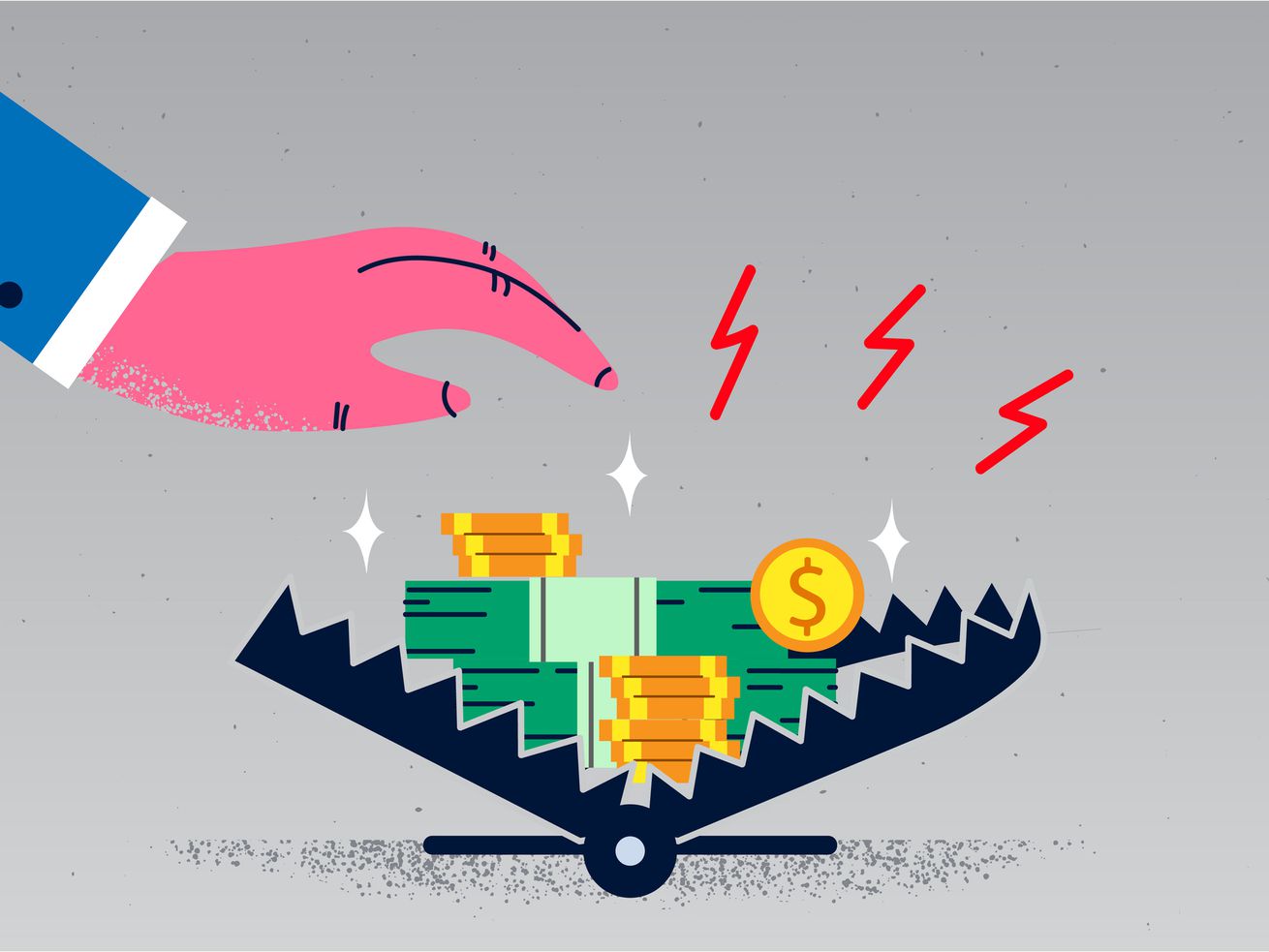There’s how you think about investment risk — and then how you feel about it.
Investing can feel very good when things are going well. It can also feel very not good when things are not going well. Case in point: If you were investing (or, let’s be honest here, speculating) in crypto in the fall of 2021, you probably were much happier with the situation than, say, if you were doing so in the summer of 2022.
Conventional wisdom goes that you’re not supposed to factor in emotions at all when you invest, or at least you’re supposed to try to keep your emotions out of them as much as possible. To the extent that’s not possible for you, it’s important to know, too.
Investing is inherently risky, no matter how supposedly safe or speculative the asset, and not everyone is equipped to handle risk equally. Finding the right risk-reward mix is a tricky balance. There’s also a difference between risk capacity, meaning the risk you should take to meet your financial goals, and risk tolerance, meaning how much risk you can deal with emotionally. You don’t want your retirement account to keep you up at night. You also don’t want to keep your money in cash your whole life and then run out of money once you actually retire because you never invested it.
“Different people at different times in their lives and with different investments are more able to accept volatility,” said Zach Teutsch, managing partner at Values Added Financial. Experts generally say younger people are better off in riskier investments, such as stocks, because they’re better able to wait out a downturn than someone older and closer to retirement. But there’s more to it than stocks vs. bonds vs. retirement date.
There is no surefire formula for determining how much risk you can and should take on in investing, and it’s definitely not a one-size-fits-all situation. But as you approach investing — whether you’re already in the market or considering it — it’s absolutely something to keep thinking about.
“You really need to start having a risk-reward conversation with yourself and be honest with yourself about what your risk tolerance is. You really need to ask yourself, ‘How much am I okay losing?’” said Kristin Myers, editor-in-chief of The Balance, a finance website. She said you also have to think about how much potential opportunity you’re comfortable with losing out on if you’re super risk averse. “I challenge people, when it comes to risk, to really think about the potential and the upside, the opportunity for reward,” she said, “especially if you’re in it for the long term.”
Here are some ideas on how to think about measuring investing risk in your own life — though to be clear here, neither I nor Vox can provide financial advice. I also want to be clear that we’re largely talking about more traditional investments like the stock market, and not crypto, which can be quite a bit different risk-wise.
Figure out your goals and what it will take to achieve them
When investors are thinking about their risk tolerance in investing, a lot depends on what the investment wealth will be used for, explained Hersh Shefrin, a professor of finance at Santa Clara University’s Leavey School of Business, in an email. Essentially, that means think about your goals. If it’s for retirement, figure out when you’re looking to retire, and what your needs will be when you do. The same advice goes for if you’re investing to pay for a vacation or a new car or education or your kids’ weddings. Ask yourself when you want to pay for something, how much it will cost, and what you’ll need to invest to try to get there. Talk to your partner or anyone you share finances with as well, so that you’re on the same page about what you want to achieve.
Missing goals can feel like a failure to people, and a failure they’d like to avoid, so it’s important to keep that in mind as well. “Asking how much can I afford to lose is about asking what amount corresponds to failure, either partial or total,” he said. “Tolerance for risk is often tied up with two questions: how important is a goal and how ambitious is the goal? People who set ambitious goals and feel very strongly about achieving those goals will take a lot of risk.”
Once you figure out the goals, then that’s the time to think about the investing plan. I’m not going to tell you what the plan should be, but once you do have one in place, it’s important to recognize that the going at some points could get a little tough. Part of figuring out your risk profile is determining what you want to do if that happens — and do that ahead of time.
Shefrin said it’s important to have policies in place so that you’re not overcome in the heat of the moment and make a decision you’ll later come to regret. “In cool, calm moments, write yourself a letter laying out a policy of how you will behave in a few different scenarios, so that you are prepared,” he said.
Have a talk with yourself about your risk tolerance and biases
One important thing to keep in mind in investing is you do not want to be investing money you absolutely need in the near term. If it’s money that you have to have to pay your rent or buy groceries, it’s best to keep it in cash. Ups and downs are part of the process in the market, and you don’t want to get caught in a down moment in a tough spot.
Michael Pompian, founder and chief investment officer at Sunpointe Investments and an expert in behavioral finance, said he generally looks at prospective 10-year returns when making investment plans for his clients, and he thinks people should look at least at a five-year horizon, meaning the amount of time you’re able to stick with the investment until you need the money back. “If you need that money in the next year or two, you shouldn’t be investing with risky investments, with stocks,” he said. He has a risk tolerance questionnaire he gives to clients that is, in part, behavioral, asking people if their portfolios go down, how they’ll feel. If you don’t have an adviser — and many people don’t — you can have this conversation with yourself.
Investors should think of their biases heading in and be aware of them as they proceed. In financial decisions, experts generally talk about cognitive biases and emotional biases. Cognitive biases are concepts and beliefs that may or may not be true; emotional biases are more in-the-moment.
For example, maybe you’re engaged in confirmation bias, where you’re seeking out information that reaffirms what you already think (that a stock is a good or bad pick, say), or you’re dealing with the endowment effect, where you’re putting more value on something you already own than you should. Some investors are overly averse to loss or to risk, or maybe they’re a bit of an adrenaline junkie. Sometimes, investors get caught up believing patterns will just stay as they are, so a bull market will stay a bull and a bear market a bear. Or, when things go poorly, they panic.
“When you’re talking to someone who’s driven by emotion, numbers often don’t resonate,” Pompian said.
He said once people think through what their biases are, that’s when they should think about what kind of investor they are — and warned that emotional investors might have a bit more difficulty dealing with ups and downs.
“How you feel about something is typically stronger and more difficult to change than how you think about something,” Pompian said. “If you tend to get emotional about your investing, that’s where you really want to make sure you’re not taking too much risk.”
That might also play into what you want to invest in. One of the principles of investing is that the more individualized risk you take — say, by betting on a single stock — the more potential upside but also the more potential losses. It’s important to understand the difference between diversified and concentrated investment and realize which one you’re in.
People tend to believe that they can time the market and, ultimately, beat it, even though chances really are they can’t. Warren Buffett famously once bet a guy the S&P 500 would beat hedge fund managers over the course of a decade and won. So when thinking about biases, you might also be a little biased toward believing in your own talent.
“Smart people are used to going through life and realizing that when they apply their intelligence to situations, they achieve better outcomes, and that’s true for a lot of things,” Teutsch said. For example, you learn that if you study for a test, you do better. “But investment is different. All the things smart people have learned throughout their entire life, that they do better than normal people, are not really true with investing.”
Recognize there are risks in investing — and in sitting it out
A lot of the time when thinking about risk, you might associate it with people taking on too much uncertainty in a way that loses them money — someone who hopped into crypto or a meme stock hoping it would make them a millionaire and got wiped out. But there’s risk in inaction, too, that’s worth considering.
Teutsch pointed to the example of money for retirement. If you put your 401(k) in exchange traded funds (ETFs), meaning funds that track little baskets of assets like stocks, and other investments with a target retirement date, chances are really high that you will have more money by the time that date arrives. (The S&P 500 historically has an average annualized return of about 10 percent.) But if you just leave the money parked in cash, you increase the likelihood that after you retire, you won’t have money at some point. “It’s pretty clear to people which risk they’re more concerned with,” Teutsch said.
In moments where the market falls, though, it’s easy to get anxious and forget. It can be tempting to panic and sell to try to avoid further losses, without recognizing that in all likelihood those losses will later be recouped.
That’s why a lot of investors fail, Teutsch said, because “they invest in investments which are more volatile than makes sense for their psychology and then respond to down markets poorly.”
Think about it: If an investor panicked and sold when stocks crashed in 2020 when the Covid-19 pandemic hit, they would have missed out on a bunch of subsequent gains as the market rebounded. Currently, the markets are down again — and if you panic and sell at lows, you could be out for some big losses in the future. It doesn’t mean you absolutely shouldn’t sell (once again, I cannot give you financial advice), but you should think before you act.
It’s important to try to keep your emotions in check when your investments are going well, too. You don’t want to get super attached to an investment that’s gone up to the point that you don’t realize it might be time to sell and take some of your gains. Take the example of Peloton, the share price of which soared in the earlier days of the pandemic as people hopped onto the exercise-from-home train. Shares of the stock have now seen deep declines, and the company’s market cap has fallen from a peak of about $50 billion to under $4 billion now. Peloton rides may be really fun and great, but holding onto the stock, not so much.
“Stop holding onto a stock because you like it,” Myers said. “Just because you like your Tesla doesn’t mean that you need to be heavily invested in the company, especially if the company isn’t doing that well.”
There’s a gender element here you might want to keep in mind, too — namely, women are on average more risk-averse than men. It obviously comes down to the individual, but women might want to take a little more risk than their instincts, and men a little less.
Keep evaluating
How you think about risk in investing is something that’s probably going to change over time. How well you’re able to weather downturns might change, say, as you get nearer to retirement, or if you realize you want that money to buy a house. It’s also a good idea to check in on your investments — Myers suggests once a quarter — and consider if you want to make any changes. Check in with yourself about how you’re feeling about where your money is, and whether you’re letting those feelings guide you a little too much.
“It’s really just always about ruthless questioning of yourself at all times,” Myers said.
The hard truth, Teutsch explained, is that investing is supposed to be boring — and if you’re having fun with it, that might be reason to worry. A little speculation in moderation is fine, but it’s not the same as investing long-term with a plan. It’s exciting to watch the line go up, but at some point, the line’s going to go down, and you’re not going to be able to guess perfectly ahead of time when it will. “Investment shouldn’t be exciting,” Teutsch said.
The way to think about markets over the long run is that they’re sort of like walking up a hill with a yo-yo. If you look at the yo-yo, then you see it going up and down and up and down. But if you pay attention to the hill, then you see you still end up on top of it at the end.
Investing can be intimidating, especially the prospect of losing money. And in moments like the current one, when markets broadly are down, the entire endeavor can feel pretty bad. It’s important to remember things in all likelihood will not be like this forever. (If the stock market were to completely implode, we would probably have much bigger problems on our hands.) But it is also a good moment to think about risk and uncertainty in investing a little, how you feel about it, and make sure some of your feelings are leading you to make decisions you’ll later regret.
“What’s interesting about periods like this is if you’ve never been through it, it will teach you about risk taking,” Pompian said. It’s advice that might not make you feel better right now, but it is true.
Even Better is here to offer deeply sourced, actionable advice for helping you live a better life. Do you have a question on money and work; friends, family, and community; or personal growth and health? Send us your question by filling out this form. We might turn it into a story.
Author: Emily Stewart
Read More



